Recover Dining Chairs
So your dining chairs are looking a little tatty. Perhaps the seat fabrics are stained, marked, torn, threadbare, or just looking rather dated and no longer suit your decor. Time to throw them out and start saving up for some new ones, perhaps? Don't be silly! For a start, chairs are really expensive (I mean, easily £100 each for nice ones!). If the chair frame is still sound, then DIY re-upholstery or re-covering of the chair pads is a job which should be within the grasp of anyone with a few basic craft and DIY skills.
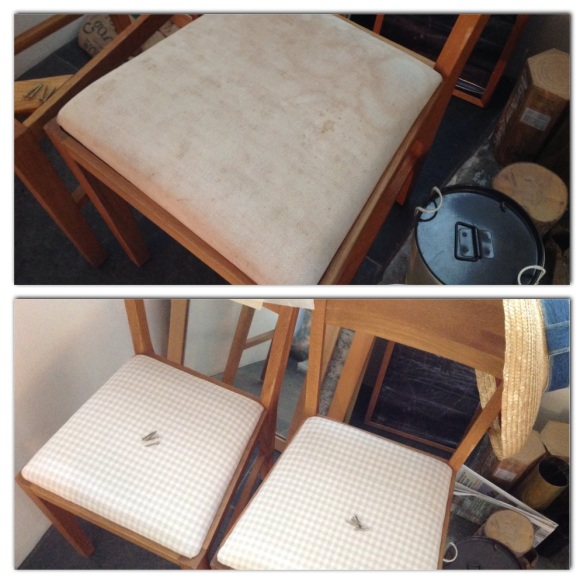
In order to do this job properly, you will require –
- A chair or chairs in need of restoration
- Staple-removing tool or tools
- Heavy-duty staple gun suitable for upholstery tasks, and staples
- Replacement covering fabric, of the mid to heavyweight upholstery type
- New bottoming fabric (non-woven synthetic material)
- Replacement seat foam (optional, see later)
- Basic everyday tools such as scissors, screwdrivers, iron and ironing board
- Adhesive spray and stain-repellant spray may also be useful
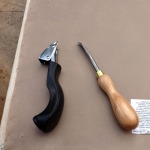 It is possible to cut corners on the equipment list, of course – you can remove staples using a flat-headed screw driver (not one you're particularly fond of, as it will never be the same again!) and a reasonably heavy-duty desk stapler could be pressed into service instead of a staple gun, but having the right tools will make the job an awful lot easier and quicker, not to mention safer for you! A staple gun and hinged-type staple remover should set you back about £10 between them, so won't break the bank.
It is possible to cut corners on the equipment list, of course – you can remove staples using a flat-headed screw driver (not one you're particularly fond of, as it will never be the same again!) and a reasonably heavy-duty desk stapler could be pressed into service instead of a staple gun, but having the right tools will make the job an awful lot easier and quicker, not to mention safer for you! A staple gun and hinged-type staple remover should set you back about £10 between them, so won't break the bank.
I would definitely replace the seat foam if the chair is imported, or is older than the 1988 UK fire safety regulations, as upholstery foams before this date (and some of those still in use overseas) can be incredibly flammable. If you know your chairs are more recent than this, and the seat foam is in good condition, not stained or breaking down, then it's reasonable to re-use what you have. This is what I've done in this tutorial, as I know the chairs are at most six or seven years old and were originally manufactured here in the UK. Obviously this is a DIY job for my own use, the chairs won't be labelled as complying with the regulations after re-covering, and consequently will not be suitable for sale or for use in a furnished rented property.
I want these chairs to last me many more years, so I'm doing this properly – yes, you could just wrap an extra layer of fabric over what's there already and staple it down, it's a quick-and-dirty approach which will save you a lot of time and effort, but you will inevitably add bulk, particularly at the corners and underneath, and the seat pads may very well not sit properly afterwards. Stripping the seat pads down is pretty hard work and takes time, but for me it's worth it in terms of the quality of the eventual finish.
Right, to work!
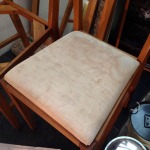 These are the chairs I'm re-upholstering. I bought them from eBay to match four I already have, but they are very stained and all my stain removal efforts have failed. If you turn your chair over, it's very likely that you will find the seat pad held on by four screws through the base, one at each corner. Remove these and set the screws aside, you'll need them again later.
These are the chairs I'm re-upholstering. I bought them from eBay to match four I already have, but they are very stained and all my stain removal efforts have failed. If you turn your chair over, it's very likely that you will find the seat pad held on by four screws through the base, one at each corner. Remove these and set the screws aside, you'll need them again later.
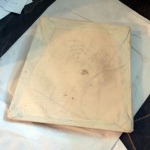 Remove the seat pad and turn it over. The view that greets you will probably be a bit like this one, a sheet of bottoming cloth held on with staples all the way around. This is light non-woven fabric, generally, and while it's tempting just to rip it off, you're going to want to remove all the staples anyway, so you might as well get started. Leaving staples in situ is a tempting effort-saving decision (trust me, it will once you've taken a few out!) but will interfere with neat tidy fitting of the new fabrics later on, and may affect the way the seat pad fits back into the chair.
Remove the seat pad and turn it over. The view that greets you will probably be a bit like this one, a sheet of bottoming cloth held on with staples all the way around. This is light non-woven fabric, generally, and while it's tempting just to rip it off, you're going to want to remove all the staples anyway, so you might as well get started. Leaving staples in situ is a tempting effort-saving decision (trust me, it will once you've taken a few out!) but will interfere with neat tidy fitting of the new fabrics later on, and may affect the way the seat pad fits back into the chair.
Personally I find having one of the wooden-handled, curved, pointy staple removing tools a real benefit, even though they're quite expensive (expect to pay about £15 for a new one – but it will last you a lifetime) – I use it on the staples first, just to 'break' the back of them and make a little space in the centre. Then I use the jointed plastic handled tool, which grips the staples to pull them out evenly. You could save a little money and buy just one or the other – they will do the job on their own but the curved tool struggles sometimes when one side of the staple comes free first, and you'll need pliers to pull out the other end. The plastic tool has a chunkier tip and is much less easy to squeeze under the tight staple to start with.
 I mentioned you could use a screwdriver – well, you can, but it's not the right tool for the job, you'll damage the corners using it for leverage, and will require a lot more force to use, too. All of which means it's a lot more likely to slip, and damage parts of the chair you want to keep. Or, you know, your fingers. Obviously you should keep all your fingers *behind* any tool you're using like this (be it a screwdriver or a proper staple removing tool). Don't say you haven't been warned!
I mentioned you could use a screwdriver – well, you can, but it's not the right tool for the job, you'll damage the corners using it for leverage, and will require a lot more force to use, too. All of which means it's a lot more likely to slip, and damage parts of the chair you want to keep. Or, you know, your fingers. Obviously you should keep all your fingers *behind* any tool you're using like this (be it a screwdriver or a proper staple removing tool). Don't say you haven't been warned!
Once the bottoming fabric has been removed, you'll find even more staples holding on the top fabric. You've guessed it, these all need to go too. In all, it's quite likely there will be well over 100 staples in each seat. It's a long old job and until you get the knack of it can easily take over an hour for each chair. But it's worth it for the quality of the eventual result.
Finally, you'll have all the fabric off the seats. Probably, what you're left with will be a wooden (plywood or chipboard usually) board and a foam pad, which may or may not be glued together. If they're not glued down, or you're replacing the foam pad, then it may be worth turning the board the other way up before re-fitting, particularly if it's chipboard and crumbling a little where the old staples have been. If you're replacing the foam, it's easiest to take one of the existing pads to a foam supplier and ask them to cut replacements the same size and shape for you – most will be happy to do this though they may charge you something to do it. I'm keeping the foam pads, because they're relatively new and in good condition still.
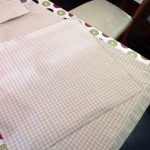 You've probably chosen your replacement fabric already, and really anything could work, so let your imagination run wild! The fabric I have used is actually salvaged from a pair of heavy cotton curtains we found in the house when we got here. I'd taken them down and washed them as I didn't like them where they were, but the subtle neutral check pattern makes a great seat and goes really well with the natural oak of the chair frames. And also, you know, it's free, which is awesome!
You've probably chosen your replacement fabric already, and really anything could work, so let your imagination run wild! The fabric I have used is actually salvaged from a pair of heavy cotton curtains we found in the house when we got here. I'd taken them down and washed them as I didn't like them where they were, but the subtle neutral check pattern makes a great seat and goes really well with the natural oak of the chair frames. And also, you know, it's free, which is awesome!
If you're buying fabrics to use, a thrifty option could be to have a look at the second hand curtains for sale in local charity shops, where you may find a real vintage bargain! Try to choose a fabric of a similar weight to the one that you've removed, as this should make the seat pad fit back into position best, without unexpected gaps or excessive thickness. If you're buying new, don't feel you need to restrict yourself to upholstery fabrics – for a little job like this, clothing fabrics like denim or a heavyweight woollen cloth could make great alternatives. Do bear in mind that a fabric with an obvious check or stripe, like mine, will show up any wonkiness and uneven tension in the fabric re-fitting much more than a fabric without!
Pre-wash, dry, and then carefully iron your fabric before cutting out. I hate ironing as much as the next person (in fact, I pretty much only ever iron at all if I'm doing a sewing or textiles project!) but do go to the trouble of doing this, it's important I promise! Washing your fabric first should both shrink it, if necessary, and improve your chances of removing stains from it in the future, should you need to, without causing colour run.

Using the old seat fabric as a template, cut out your new seat covers. I prefer to cut a little larger, and to cut to square corners, without 'scalloping' them out. This just provides more of a margin of error for the fitting process! If there's any risk of confusion, mark the 'wrong' side of your fabric clearly when you cut it out, to ensure it goes on the chair right-side-out! If your seat foam isn't already glued down to the wood, consider using some spray adhesive to do this, as if the two are fixed in position already, it will make stretching the fabric over them much more straightforward.
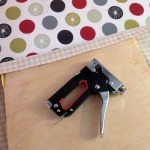 Then, starting along the straightest edge of your seat pad, secure the fabric with your staple gun. The first side is simple, but of course it gets a bit trickier after that. Do the opposite side next, so that your fabric is nice and straight. While it *is* possible to stretch, hold, and staple the fabric on your own, this task is a lot easier if you can recruit a glamorous assistant to help you (hello, Hubby!).
Then, starting along the straightest edge of your seat pad, secure the fabric with your staple gun. The first side is simple, but of course it gets a bit trickier after that. Do the opposite side next, so that your fabric is nice and straight. While it *is* possible to stretch, hold, and staple the fabric on your own, this task is a lot easier if you can recruit a glamorous assistant to help you (hello, Hubby!).
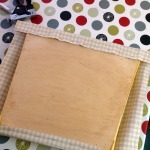 You will want to pull the fabric as tight as you can, and this will curve and round-off the cut edges of the foam in the process. Work slowly and keep the tension even. I tend to work in a divide-the-difference pattern, placing each new staple in the centre of a gap, rather than trying to work along a line from one end to the other.
You will want to pull the fabric as tight as you can, and this will curve and round-off the cut edges of the foam in the process. Work slowly and keep the tension even. I tend to work in a divide-the-difference pattern, placing each new staple in the centre of a gap, rather than trying to work along a line from one end to the other.
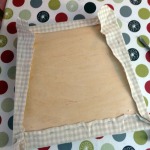 Then do the same with the two other sides, though you might find it easier to work on both sides alternately, rather than securing one side and then the other. Just keep checking your tension is even and appropriate as you go along, and don't be nervous of taking staples out and trying again if you're not happy with the result!
Then do the same with the two other sides, though you might find it easier to work on both sides alternately, rather than securing one side and then the other. Just keep checking your tension is even and appropriate as you go along, and don't be nervous of taking staples out and trying again if you're not happy with the result!
Once you've finished the sides, fold the corners over neatly and secure these too.
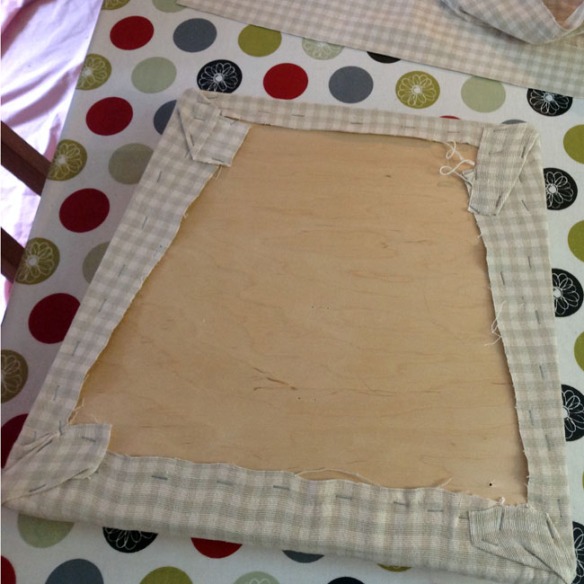
With a bit of luck, you'll end up with seat pads that look a bit like this. Now just to finish the bottoms. You could re-use the bottoming cloths that you took off in the first place – if you managed to get them off without tearing – but they'll look tatty and new non-woven fabric to replace them is very cheap (it's usually available in black, grey, white, or beige and costs a couple of pounds a metre, so choose the one that will blend in best). You could even forget about it and just re-fit the seats as they are, but that will leave the raw edges of your covering fabric exposed and these will eventually fray.
 A word to the wise – take it from me, and do not attempt to iron your bottoming fabric. Doing so (even on your iron's lowest setting) will result in ruined fabric and a nasty sticky mess on the bottom of your iron. Do you really need to ask how I know this..?
A word to the wise – take it from me, and do not attempt to iron your bottoming fabric. Doing so (even on your iron's lowest setting) will result in ruined fabric and a nasty sticky mess on the bottom of your iron. Do you really need to ask how I know this..?
 Cut out the bottoming cloth using the old one as a template, and then staple this in place over the seat bottom, concealing all the rough edges and staples securing your top fabric as you do.
Cut out the bottoming cloth using the old one as a template, and then staple this in place over the seat bottom, concealing all the rough edges and staples securing your top fabric as you do.
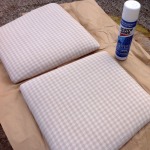 Mindful of why I had this job to do in the first place, I got out my trusty can of Scotchgard spray (other stain repellant products are available) and treated the re-upholstered seat pads before re-fitting them. This would also be a good time to make any repairs to the wooden chair frames, and oil, varnish, or even paint these if necessary.
Mindful of why I had this job to do in the first place, I got out my trusty can of Scotchgard spray (other stain repellant products are available) and treated the re-upholstered seat pads before re-fitting them. This would also be a good time to make any repairs to the wooden chair frames, and oil, varnish, or even paint these if necessary.
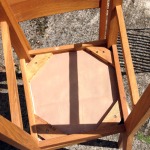 Once everything is done, re-fit the seat pads using the screws you set aside at the beginning, and stand back and admire your handiwork! Aren't they fine? I've only got another four to do, now!
Once everything is done, re-fit the seat pads using the screws you set aside at the beginning, and stand back and admire your handiwork! Aren't they fine? I've only got another four to do, now!
Just consider the possibilities – old dining chairs in need of re-upholstery sell online and in general auctions for pennies on the pound compared to new ones. Doing the job yourself takes a little time and effort, but you can produce a really professional looking result, save a heap of money, and bring a great vintage feature into your home, too!
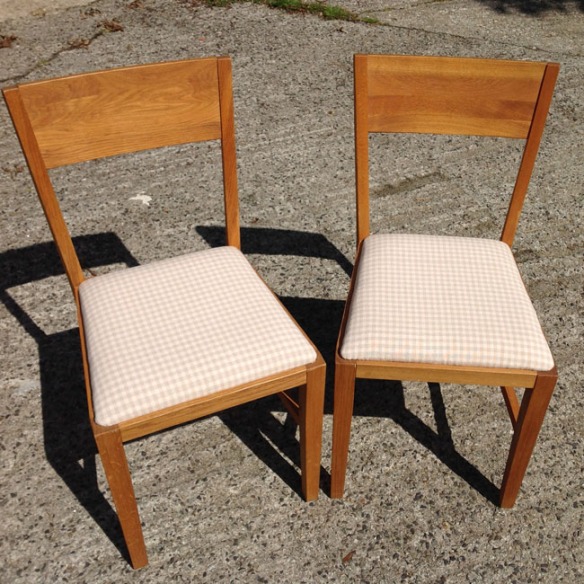
Still doubt that this is a beginner's project? Well, these chairs are the first things I've ever upholstered. If I can do it, I have no doubt that you can, too!
Read more from the Country Skills blog >>

Source: https://countryskillsblog.com/2014/08/24/take-a-seat-how-to-re-upholster-a-dining-chair-for-complete-beginners/

0 Komentar